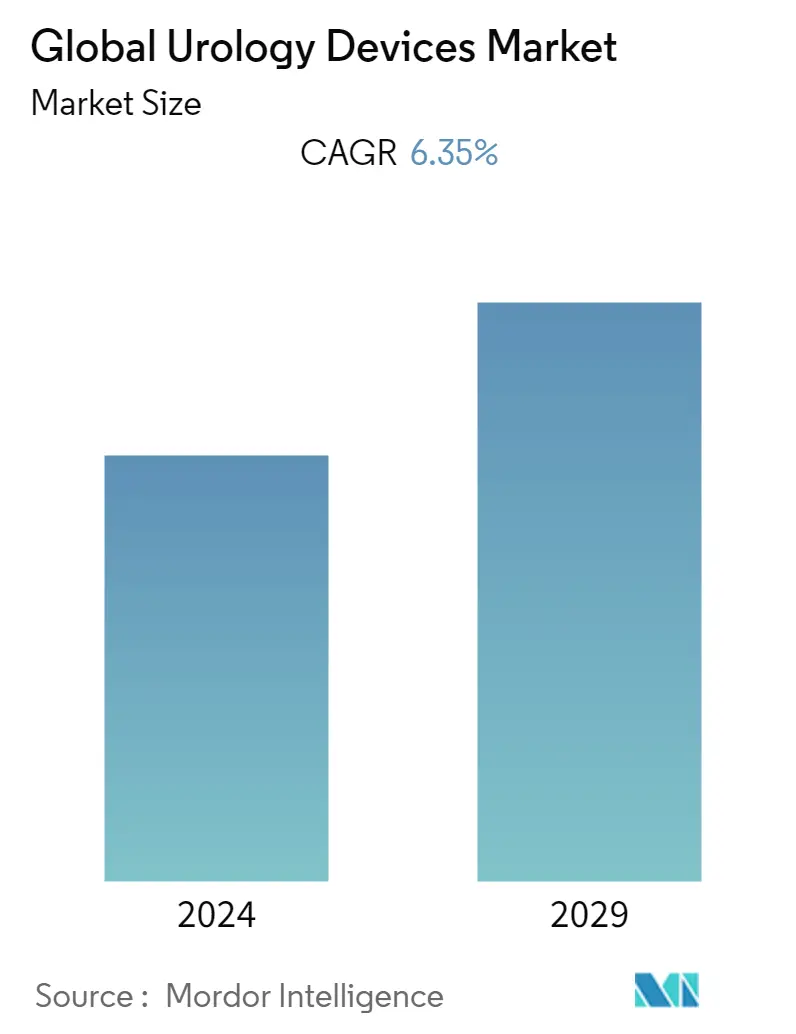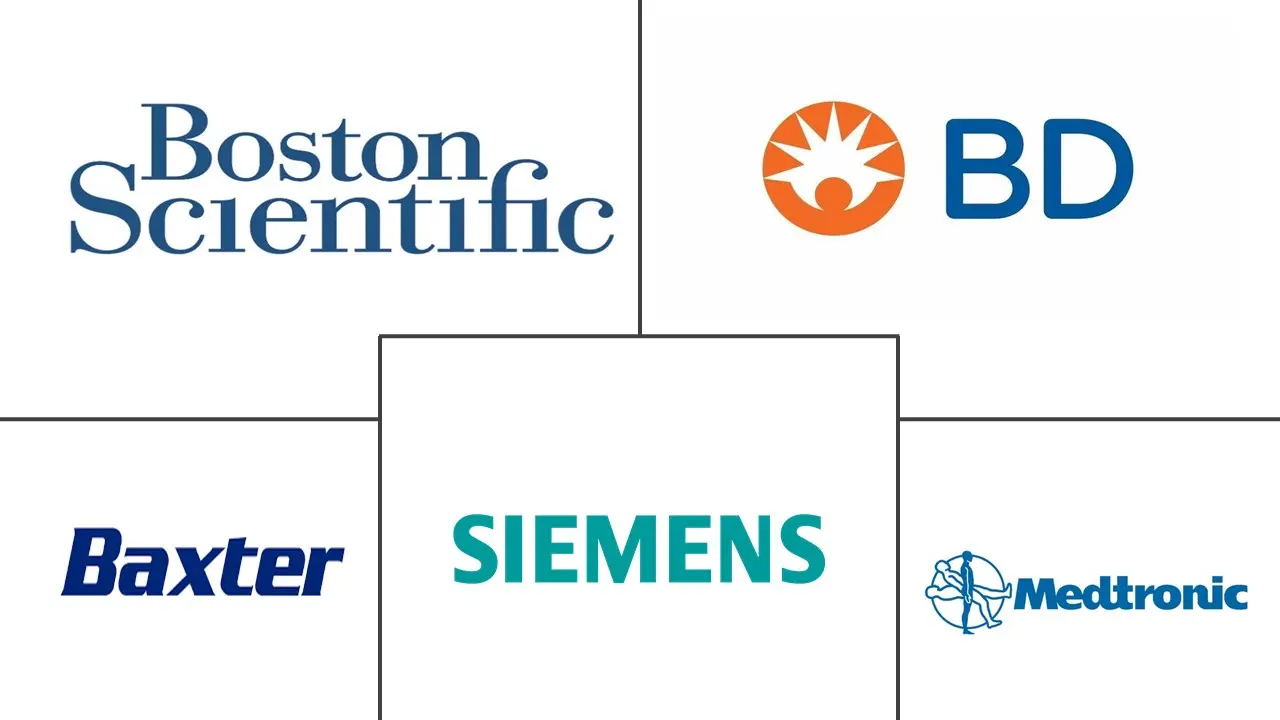Market Size of Global Urology Devices Industry

| Study Period | 2019 - 2029 |
| Base Year For Estimation | 2023 |
| CAGR | 6.35 % |
| Fastest Growing Market | Asia Pacific |
| Largest Market | North America |
| Market Concentration | High |
Major Players
*Disclaimer: Major Players sorted in no particular order |
Urology Devices Market Analysis
The global urology devices market is growing at a rate of 6.35% during the forecast period (2022-2027).
The global spread of COVID-19 has flooded many healthcare institutions with severely ill patients and medical equipment such as dialysis machines, endoscopes, and lithotripsy machines. COVID-19 causes acute respiratory distress and acute renal damage in individuals. Multi-organ failure and renal failure can occur when the patient's body cannot remove excess waste and fluids from the body. As a result of the use of dialysis equipment in the treatment of patients, the urology device market has a beneficial impact on COVID-19. However, urology practices have decreased during the pandemic. Thus, COVID-19 has a mixed impact on the market studied.
The key factors propelling the market growth include a high incidence of urologic conditions, a rising senior population, and technological advancements.
According to the American Urological Association Foundation (AUAF), benign prostatic hyperplasia (BPH), urinary incontinence (UI), urinary tract infections (UTIs), and kidney and ureteral stones are among the most common urological diseases. The United States According to the National Institute of Medicine July 2020, urinary tract infection affects approximately 150 million people globally. In addition, about 11% of women visit one physician yearly for urinary tract infection treatment. Urinary tract infections (UTIs) are among the most common microbial diseases affecting people of all ages. Globally, UTIs affect around 150 million people every year. Diabetic patients have a higher risk of developing UTIs. With a global increase in the diabetic population, complications like dysuria and organ damage are associated with UTIs, which are also rising.
Additionally, according to the article published in the International Journal of Molecular medicine in August 2020, Kidney stone disease, also known as nephrolithiasis or urolithiasis, is one of medicine's oldest diseases. It is estimated that 11% of people will develop kidney stones at some point in their lives, and the prevalence and incidence of kidney stones are increasing worldwide. However, the overall prevalence of urolithiasis was 11.2 %, with 48.8 % having a first-degree relative with the disease. Males were 1.8 times more likely than females to have urolithiasis.
Hence, with the high incidence rates and health complications associated with urological diseases, there is an increasing demand for healthcare interventions to manage them, which, in turn, is propelling the market of urology devices market.
Urology Devices Industry Segmentation
As per the scope of the report, urological conditions include kidney stone disease (urolithiasis), incontinence in men and women, benign prostate hyperplasia (BPH), and noncancerous prostate swelling in men with increasing age, prostate cancer, and erectile dysfunction in men. Therefore, urologists utilize these devices for the treatment of urinary disorders. The Urology Devices Market is segmented by Product, Disease (Instruments, consumables, and Accessories), By Diseases(Kidney Diseases, Urological Cancer and BPH, Pelvic Organ Prolapse, Other Diseases), and Geography (North America, Europe, Asia-Pacific, Middle East & Africa, and South America). The report offers the value (USD million) for the above segments.
| By Product | |||||||
| |||||||
|
| By Disease | |
| Kidney Diseases | |
| Urological Cancer and BPH | |
| Pelvic Organ Prolapse | |
| Other Diseases |
| By End User | |
| Hospitals and Clinics | |
| Dialysis Centers | |
| Other End Users |
| Geography | ||||||||
| ||||||||
| ||||||||
| ||||||||
| ||||||||
|
Global Urology Devices Market Size Summary
The urology devices market is experiencing significant growth, driven by a combination of factors including the high incidence of urological conditions, an aging population, and rapid technological advancements. The market's expansion is further influenced by the increasing prevalence of diseases such as benign prostatic hyperplasia, urinary incontinence, and kidney stones, which necessitate advanced medical interventions. The COVID-19 pandemic had a mixed impact on the market; while it increased the demand for dialysis machines due to renal complications in severely ill patients, it also led to a decrease in urology practices. Despite these challenges, the market is poised for growth, supported by heightened awareness, government initiatives, and innovations aimed at providing cost-effective treatments.
North America currently leads the urology devices market, with a strong focus on technological innovations and diagnostic methodologies, particularly for urinary tract infections. The region's dominance is expected to continue, bolstered by ongoing advancements and strategic collaborations among key players. The competitive landscape is characterized by the presence of major companies such as Baxter, Boston Scientific, and Medtronic, alongside mid-size and smaller firms introducing innovative devices at competitive prices. These dynamics, coupled with increasing funding and a high volume of urology cases, are anticipated to drive the market's growth over the forecast period.
Global Urology Devices Market Size - Table of Contents
-
1. MARKET DYNAMICS
-
1.1 Market Overview
-
1.2 Market Drivers
-
1.2.1 High Incidence of Urologic Conditions
-
1.2.2 Rising Geriatric Population
-
1.2.3 Technological Advancements
-
-
1.3 Market Restraints
-
1.3.1 Stringent Regulatory Policies for Validation of Medical Devices
-
1.3.2 High Cost of Urology Devices
-
-
1.4 Porter's Five Forces Analysis
-
1.4.1 Threat of New Entrants
-
1.4.2 Bargaining Power of Buyers/Consumers
-
1.4.3 Bargaining Power of Suppliers
-
1.4.4 Threat of Substitute Products
-
1.4.5 Intensity of Competitive Rivalry
-
-
-
2. MARKET SEGMENTATION (Market Size by Value - USD million)
-
2.1 By Product
-
2.1.1 Instruments
-
2.1.1.1 Dialysis Devices
-
2.1.1.2 Endoscopes and Endovision Systems
-
2.1.1.3 Lasers and Lithotripsy Devices
-
2.1.1.4 Other Instruments
-
-
2.1.2 By Consumables and Accessories
-
2.1.2.1 Dialysis Consumables
-
2.1.2.2 Guidewires and Catheters
-
2.1.2.3 Stents
-
2.1.2.4 Biopsy Devices
-
2.1.2.5 Other Consumables and Accessories
-
-
-
2.2 By Disease
-
2.2.1 Kidney Diseases
-
2.2.2 Urological Cancer and BPH
-
2.2.3 Pelvic Organ Prolapse
-
2.2.4 Other Diseases
-
-
2.3 By End User
-
2.3.1 Hospitals and Clinics
-
2.3.2 Dialysis Centers
-
2.3.3 Other End Users
-
-
2.4 Geography
-
2.4.1 North America
-
2.4.1.1 United States
-
2.4.1.2 Canada
-
2.4.1.3 Mexico
-
-
2.4.2 Europe
-
2.4.2.1 Germany
-
2.4.2.2 United Kingdom
-
2.4.2.3 France
-
2.4.2.4 Italy
-
2.4.2.5 Spain
-
2.4.2.6 Rest of Europe
-
-
2.4.3 Asia-Pacific
-
2.4.3.1 China
-
2.4.3.2 Japan
-
2.4.3.3 India
-
2.4.3.4 Australia
-
2.4.3.5 South Korea
-
2.4.3.6 Rest of Asia-Pacific
-
-
2.4.4 Middle-East and Africa
-
2.4.4.1 GCC
-
2.4.4.2 South Africa
-
2.4.4.3 Rest of Middle-East and Africa
-
-
2.4.5 South America
-
2.4.5.1 Brazil
-
2.4.5.2 Argentina
-
2.4.5.3 Rest of South America
-
-
-
Global Urology Devices Market Size FAQs
What is the current Global Urology Devices Market size?
The Global Urology Devices Market is projected to register a CAGR of 6.35% during the forecast period (2024-2029)
Who are the key players in Global Urology Devices Market?
Baxter International Inc., Boston Scientific Corporation, Becton, Dickinson and Company, Medtronic PLC and Siemens Healthineers are the major companies operating in the Global Urology Devices Market.

